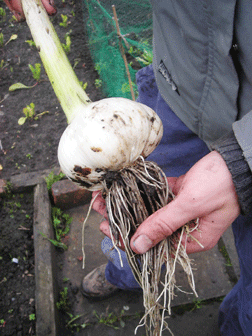 The Bay Gardener by Dr. Frank Gouin
The Bay Gardener by Dr. Frank Gouin
Grow Your Own Elephant Garlic
Garlic grows over winter for early summer harvest

If you enjoy eating roasted elephant garlic but don’t relish having to buy it at the grocery store, consider growing your own. Most seed catalogs — such as Johnny Seeds, Territorial Seeds, Park’s Seed, Miller’s Nursery, Gurney’s — sell elephant garlic bulbs. If you don’t want to bother ordering cloves for planting, purchase good sound bulbs from your local grocery store. Squeeze those store-bought bulbs to make certain that all three or four cloves are firm.
Garlic bulbs can be planted from early September until mid November. The plants need time to produce visible foliage before the ground freezes.
Select a location in your garden that will receive maximum sunlight. Elephant garlic planted in partial shade will not produce fully developed bulbs.
Garlic grows best in well-drained soils with a pH near 6.5 and rich in organic matter. A soil test will tell you your pH and how to achieve it. To meet the organic requirements, spread about two inches of compost over the soil and spade or rototill as deeply as possible.
Plant each clove, pointed side up, in pre-made holes four inches deep and four inches apart in rows 10 inches apart. Just before the ground freezes in December, mulch with a one-inch layer of compost.
Next spring, irrigate the soil thoroughly at least twice weekly. In May, cut the flowers just below the swollen part of the stem as they form so as to maximize the size of the bulbs.
Just as soon as the leaves start to turn brown, the bulbs can be dug using a forked garden spade so as to minimize any damage to the bulbs. Take care to collect the bulblets loosely attached to the garlic bulbs because these will be the cloves you will be planting in the fall of 2009. Store these bulblets in a zipper bag in the refrigerator.
Dry the elephant garlic bulbs by tying three to four bulbs together, with their leaves still attached, and suspend them in a well-ventilated, shaded area protected from rain.
Celebrate your success by roasting a clove in your toaster oven. After peeling, cut the clove in half, spritz it with olive oil and wrap the clove in aluminum foil, if you don’t have a garlic roaster, and roast for 20 to 30 minutes at 350 degrees. The clove should be slightly brown and soft like butter when ready. Spread a portion of that clove on a cracker, sprinkle with salt and savor the flavor.